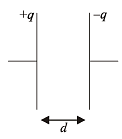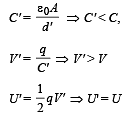JEE Exam > JEE Questions > A parallel plate capacitor is charged and the...
Start Learning for Free
A parallel plate capacitor is charged and the charging battery is then disconnected. If the plates of the capacitor are moved farther apart by means of insulating handles :
- a)the charge on the capacitor increases.
- b)the voltage across the plates increases.
- c)the capacitance increases.
- d)the electrostatic energy stored in the capacitor increases
Correct answer is option 'B,D'. Can you explain this answer?
| FREE This question is part of | Download PDF Attempt this Test |
Verified Answer
A parallel plate capacitor is charged and the charging battery is then...
Charge on plate is q


Charge on plate is q


Most Upvoted Answer
A parallel plate capacitor is charged and the charging battery is then...
Yes ans is B and D because once a capacitor is charged and after disconnecting the battery,the charge flowing in the circuit will be constant.
also C is inversely proportional to d. so as d is increased C gets decreased and voltage =Q/C. so as Q remains constant so voltage is inversely proportional to C. so as C is decreasing on increasing distance between the plates voltage will get increased.
and energy =Q^2/2C so energy is also inversely proportional to C so it will also get increased on increasing distance.
also C is inversely proportional to d. so as d is increased C gets decreased and voltage =Q/C. so as Q remains constant so voltage is inversely proportional to C. so as C is decreasing on increasing distance between the plates voltage will get increased.
and energy =Q^2/2C so energy is also inversely proportional to C so it will also get increased on increasing distance.
Free Test
| FREE | Start Free Test |
Community Answer
A parallel plate capacitor is charged and the charging battery is then...
Explanation:
Introduction:
A parallel plate capacitor consists of two conducting plates separated by a dielectric material. When a capacitor is charged, it stores electrical energy in the form of electric field between its plates. In this scenario, the plates of the capacitor are moved farther apart after charging and the charging battery is disconnected.
Bullet Points:
To understand the given options, let's analyze each one:
a) The charge on the capacitor increases:
Moving the plates farther apart does not cause any change in the charge stored in the capacitor. Charge is conserved and remains constant unless some external influence is applied. Therefore, this option is incorrect.
b) The voltage across the plates increases:
Moving the plates farther apart increases the distance between them. As a result, the electric field between the plates decreases. Since voltage is directly proportional to electric field, the voltage across the plates increases. Therefore, this option is correct.
c) The capacitance increases:
The capacitance of a parallel plate capacitor is given by the formula C = ε₀A/d, where ε₀ is the permittivity of free space, A is the area of the plates, and d is the distance between the plates. In this scenario, the area of the plates and the permittivity of free space remain constant. As the plates are moved farther apart, the distance between them (d) increases. Therefore, the capacitance decreases according to the formula. Thus, this option is incorrect.
d) The electrostatic energy stored in the capacitor increases:
The energy stored in a capacitor is given by the formula E = (1/2)CV², where C is the capacitance and V is the voltage across the plates. As mentioned earlier, the voltage (V) increases when the plates are moved farther apart. Since the capacitance (C) remains constant in this scenario, the electrostatic energy (E) stored in the capacitor increases. Therefore, this option is correct.
Conclusion:
Based on the analysis, options b) and d) are correct. Moving the plates farther apart increases the voltage across the plates and consequently increases the electrostatic energy stored in the capacitor.
Introduction:
A parallel plate capacitor consists of two conducting plates separated by a dielectric material. When a capacitor is charged, it stores electrical energy in the form of electric field between its plates. In this scenario, the plates of the capacitor are moved farther apart after charging and the charging battery is disconnected.
Bullet Points:
To understand the given options, let's analyze each one:
a) The charge on the capacitor increases:
Moving the plates farther apart does not cause any change in the charge stored in the capacitor. Charge is conserved and remains constant unless some external influence is applied. Therefore, this option is incorrect.
b) The voltage across the plates increases:
Moving the plates farther apart increases the distance between them. As a result, the electric field between the plates decreases. Since voltage is directly proportional to electric field, the voltage across the plates increases. Therefore, this option is correct.
c) The capacitance increases:
The capacitance of a parallel plate capacitor is given by the formula C = ε₀A/d, where ε₀ is the permittivity of free space, A is the area of the plates, and d is the distance between the plates. In this scenario, the area of the plates and the permittivity of free space remain constant. As the plates are moved farther apart, the distance between them (d) increases. Therefore, the capacitance decreases according to the formula. Thus, this option is incorrect.
d) The electrostatic energy stored in the capacitor increases:
The energy stored in a capacitor is given by the formula E = (1/2)CV², where C is the capacitance and V is the voltage across the plates. As mentioned earlier, the voltage (V) increases when the plates are moved farther apart. Since the capacitance (C) remains constant in this scenario, the electrostatic energy (E) stored in the capacitor increases. Therefore, this option is correct.
Conclusion:
Based on the analysis, options b) and d) are correct. Moving the plates farther apart increases the voltage across the plates and consequently increases the electrostatic energy stored in the capacitor.
Attention JEE Students!
To make sure you are not studying endlessly, EduRev has designed JEE study material, with Structured Courses, Videos, & Test Series. Plus get personalized analysis, doubt solving and improvement plans to achieve a great score in JEE.

|
Explore Courses for JEE exam
|

|
Similar JEE Doubts
A parallel plate capacitor is charged and the charging battery is then disconnected. If the plates of the capacitor are moved farther apart by means of insulating handles :a)the charge on the capacitor increases.b)the voltage across the plates increases.c)the capacitance increases.d)the electrostatic energy stored in the capacitor increasesCorrect answer is option 'B,D'. Can you explain this answer?
Question Description
A parallel plate capacitor is charged and the charging battery is then disconnected. If the plates of the capacitor are moved farther apart by means of insulating handles :a)the charge on the capacitor increases.b)the voltage across the plates increases.c)the capacitance increases.d)the electrostatic energy stored in the capacitor increasesCorrect answer is option 'B,D'. Can you explain this answer? for JEE 2024 is part of JEE preparation. The Question and answers have been prepared according to the JEE exam syllabus. Information about A parallel plate capacitor is charged and the charging battery is then disconnected. If the plates of the capacitor are moved farther apart by means of insulating handles :a)the charge on the capacitor increases.b)the voltage across the plates increases.c)the capacitance increases.d)the electrostatic energy stored in the capacitor increasesCorrect answer is option 'B,D'. Can you explain this answer? covers all topics & solutions for JEE 2024 Exam. Find important definitions, questions, meanings, examples, exercises and tests below for A parallel plate capacitor is charged and the charging battery is then disconnected. If the plates of the capacitor are moved farther apart by means of insulating handles :a)the charge on the capacitor increases.b)the voltage across the plates increases.c)the capacitance increases.d)the electrostatic energy stored in the capacitor increasesCorrect answer is option 'B,D'. Can you explain this answer?.
A parallel plate capacitor is charged and the charging battery is then disconnected. If the plates of the capacitor are moved farther apart by means of insulating handles :a)the charge on the capacitor increases.b)the voltage across the plates increases.c)the capacitance increases.d)the electrostatic energy stored in the capacitor increasesCorrect answer is option 'B,D'. Can you explain this answer? for JEE 2024 is part of JEE preparation. The Question and answers have been prepared according to the JEE exam syllabus. Information about A parallel plate capacitor is charged and the charging battery is then disconnected. If the plates of the capacitor are moved farther apart by means of insulating handles :a)the charge on the capacitor increases.b)the voltage across the plates increases.c)the capacitance increases.d)the electrostatic energy stored in the capacitor increasesCorrect answer is option 'B,D'. Can you explain this answer? covers all topics & solutions for JEE 2024 Exam. Find important definitions, questions, meanings, examples, exercises and tests below for A parallel plate capacitor is charged and the charging battery is then disconnected. If the plates of the capacitor are moved farther apart by means of insulating handles :a)the charge on the capacitor increases.b)the voltage across the plates increases.c)the capacitance increases.d)the electrostatic energy stored in the capacitor increasesCorrect answer is option 'B,D'. Can you explain this answer?.
Solutions for A parallel plate capacitor is charged and the charging battery is then disconnected. If the plates of the capacitor are moved farther apart by means of insulating handles :a)the charge on the capacitor increases.b)the voltage across the plates increases.c)the capacitance increases.d)the electrostatic energy stored in the capacitor increasesCorrect answer is option 'B,D'. Can you explain this answer? in English & in Hindi are available as part of our courses for JEE.
Download more important topics, notes, lectures and mock test series for JEE Exam by signing up for free.
Here you can find the meaning of A parallel plate capacitor is charged and the charging battery is then disconnected. If the plates of the capacitor are moved farther apart by means of insulating handles :a)the charge on the capacitor increases.b)the voltage across the plates increases.c)the capacitance increases.d)the electrostatic energy stored in the capacitor increasesCorrect answer is option 'B,D'. Can you explain this answer? defined & explained in the simplest way possible. Besides giving the explanation of
A parallel plate capacitor is charged and the charging battery is then disconnected. If the plates of the capacitor are moved farther apart by means of insulating handles :a)the charge on the capacitor increases.b)the voltage across the plates increases.c)the capacitance increases.d)the electrostatic energy stored in the capacitor increasesCorrect answer is option 'B,D'. Can you explain this answer?, a detailed solution for A parallel plate capacitor is charged and the charging battery is then disconnected. If the plates of the capacitor are moved farther apart by means of insulating handles :a)the charge on the capacitor increases.b)the voltage across the plates increases.c)the capacitance increases.d)the electrostatic energy stored in the capacitor increasesCorrect answer is option 'B,D'. Can you explain this answer? has been provided alongside types of A parallel plate capacitor is charged and the charging battery is then disconnected. If the plates of the capacitor are moved farther apart by means of insulating handles :a)the charge on the capacitor increases.b)the voltage across the plates increases.c)the capacitance increases.d)the electrostatic energy stored in the capacitor increasesCorrect answer is option 'B,D'. Can you explain this answer? theory, EduRev gives you an
ample number of questions to practice A parallel plate capacitor is charged and the charging battery is then disconnected. If the plates of the capacitor are moved farther apart by means of insulating handles :a)the charge on the capacitor increases.b)the voltage across the plates increases.c)the capacitance increases.d)the electrostatic energy stored in the capacitor increasesCorrect answer is option 'B,D'. Can you explain this answer? tests, examples and also practice JEE tests.

|
Explore Courses for JEE exam
|

|
Suggested Free Tests
Signup for Free!
Signup to see your scores go up within 7 days! Learn & Practice with 1000+ FREE Notes, Videos & Tests.
























